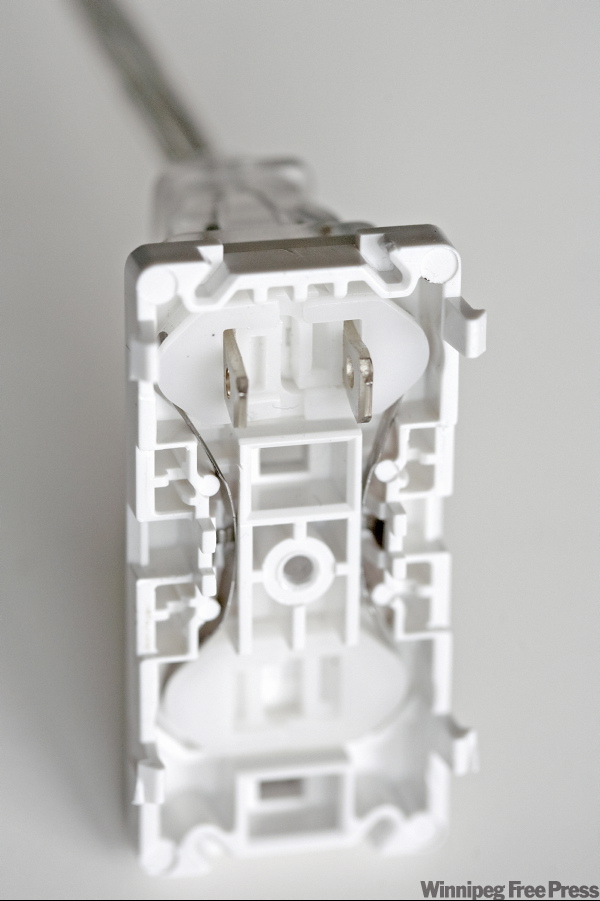Electrical code requires tamper-resistant outlets so kids won’t get a shock
Advertisement
Read this article for free:
or
Already have an account? Log in here »
To continue reading, please subscribe:
Monthly Digital Subscription
$1 per week for 24 weeks*
- Enjoy unlimited reading on winnipegfreepress.com
- Read the E-Edition, our digital replica newspaper
- Access News Break, our award-winning app
- Play interactive puzzles
*Billed as $4.00 plus GST every four weeks. After 24 weeks, price increases to the regular rate of $19.00 plus GST every four weeks. Offer available to new and qualified returning subscribers only. Cancel any time.
Monthly Digital Subscription
$4.75/week*
- Enjoy unlimited reading on winnipegfreepress.com
- Read the E-Edition, our digital replica newspaper
- Access News Break, our award-winning app
- Play interactive puzzles
*Billed as $19 plus GST every four weeks. Cancel any time.
To continue reading, please subscribe:
Add Free Press access to your Brandon Sun subscription for only an additional
$1 for the first 4 weeks*
*Your next subscription payment will increase by $1.00 and you will be charged $16.99 plus GST for four weeks. After four weeks, your payment will increase to $23.99 plus GST every four weeks.
Read unlimited articles for free today:
or
Already have an account? Log in here »
Hey there, time traveller!
This article was published 22/01/2009 (6106 days ago), so information in it may no longer be current.
TORONTO – New parents who babyproof their home normally place plastic covers over the electrical outlets, but revisions to the Canadian Electrical Code announced Thursday mean that some day that will no longer be necessary.
The updated code requires new homes to have tamper-resistant receptacles, designed to prevent children from inserting objects like hairpins, keys and nails which could cause them to receive a shock.
"The great thing is that finally we have some technology that’s actually passive – it doesn’t rely on the parent to actually make sure that there’s any covers in place," says Denyse Boxell of Safe Kids Canada.

"So we’re very, very pleased that finally there’s technology that would be permanent on the wall and would have an automatic shield closure, which is what we’ve been asking for for quite some time to prevent these kinds of injuries."
The new receptacles have a built-in shutter system that prevents anything from going into just one hole. The shutters will open only if two prongs are heading into the holes at the same time.
Boxell says it would be unlikely for a child to stick two pins into an outlet at the same time.
"We know from the research and obviously child development, and such things, that children don’t do that," she said.
"Because at the stage of development where they’re curious and they’re exploring these types of things, like what object fits into what slot, it’s beyond their level of cognition to actually do that."
And although it’s not required for existing homes, Stephen Brown, director of electrotechnical codes and standards for the Canadian Standards Association, says homeowners may wish to replace their receptacles.
"The cost of actually installing one of these receptacles is very, very inexpensive," he said in an interview.
"We may wish to do that as homeowners, just to ensure it’s a safe surrounding for children."
Boxell said anyone intending to do this should call an electrician if they don’t have the skill and training to do it themselves.
And for those who choose not to make the change, she said they can continue to use the plastic covers – although they’re not ideal.
"Research has showed that small children can still pull them out of the socket and also they’re very small so children who like to mouth things have been known to put them in their mouths and choke," she said.
"So we do strongly recommend, if you have young children, to retrofit your home and put in the new tamper-resistant receptacles."
The first version of the Canadian Electrical Code came out in 1927, and it’s routinely updated by the Canadian Standards Association, a not-for-profit member-based organization that develops and implements standards and codes. The association is celebrating its 90th birthday this week.
This is its 21st revision, Brown said.
Once an item is in the code, it’s up to the provinces to adopt it, Brown said, and he expects a majority will do so within six months.
"This is a change that actually helps protect children from electrical injuries," Boxell said.
She noted that on average, there are about four deaths each year in Canada due to electrical injuries.
"And we have about 121 emergency room visits as a result of an electrical injury, and that’s for children under the age of 14," she said.
"It’s a significant amount of kids who, unfortunately, are injured."
The code is more than 700 pages and this version includes 118 revisions, Brown said.
In addition to the electrical outlets, he said homeowners with swimming pools will find new bonding requirements for pools installed or retrofitted with saline chlorination systems.
The salt can cause corrosion to the wiring needed for lights around a pool, he noted.
As well, the code will require that carbon monoxide detectors be hard-wired into a residence so they can run on the electrical system, and not batteries that might run out and not get replaced.

